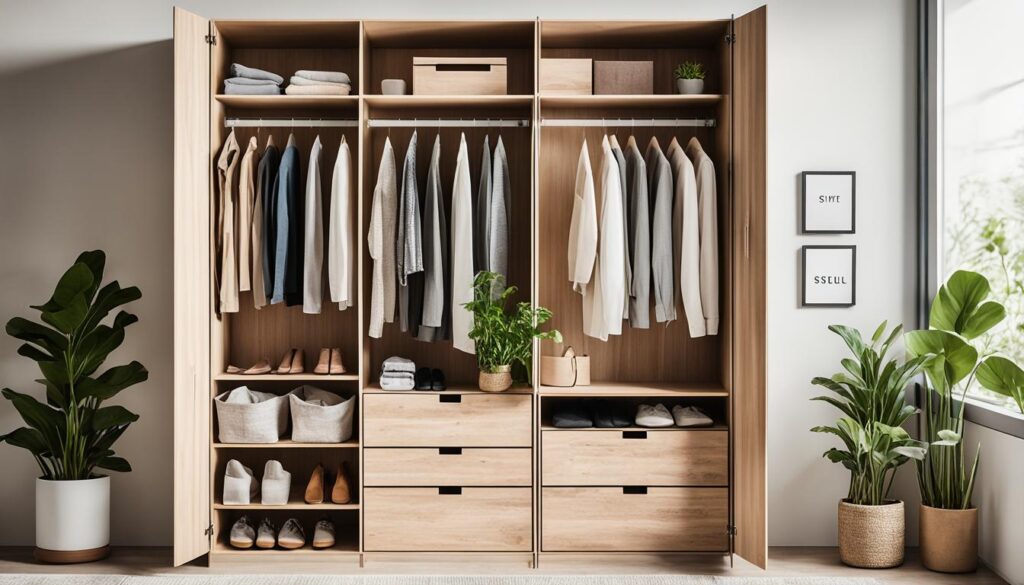The fashion industry is responsible for 10% of global greenhouse gas emissions. It consumes large amounts of water and harmful chemicals. Creating a sustainable wardrobe is an excellent way to reduce the environmental impact. It supports ethical brands and practices.
This transformation can also bring long-term financial benefits. It avoids waste and invests in durable quality pieces.
Key Highlights:
- The fashion industry has a significant environmental impact, but this footprint can be reduced through a sustainable wardrobe.
- Choosing ethical brands and sustainable practices is crucial to minimizing the damage caused by the textile industry.
- Investing in eco-friendly materials and avoiding fleeting trends helps build a more durable and cost-effective wardrobe.
- Circular economy in fashion, such as renting and buying second-hand pieces, is a sustainable alternative.
- Customizing and giving new life to old clothes through upcycling is also an interesting option.
The Meaning of a Sustainable Wardrobe
A sustainable wardrobe includes pieces made ethically and environmentally responsibly. It uses sustainable materials like natural, organic, and recycled fibers. Choosing conscious consumption habits in fashion helps reduce the environmental impact of the textile industry. This industry consumes many natural resources and generates polluting waste.
Why Adopt Conscious Consumption Habits?
Choosing brands committed to sustainability in fashion and quality pieces helps transform the sector. The fashion industry is highly polluting, responsible for 10% of global greenhouse gas emissions. It consumes a lot of water and generates harmful chemical waste.
Environmental Impacts of the Fashion Industry
Consumers are seeking more sustainable alternatives. This includes adopting wardrobes with pieces made ethically and with eco-friendly materials. The textile industry consumes many natural resources, according to the U.S. Environmental Protection Agency (EPA).
Washing clothes accounts for 60-80% of the total environmental impact of a garment, according to the Energy Saving Trust. About 100 billion pieces are produced annually, and 92 million go to landfills. This harms the soil and water. Polyester clothes can release 31 to 75 microplastic fibers per wash, polluting the oceans.
These data show the need for more sustainable solutions and conscious consumption in fashion.
Assess Your Current Wardrobe
Before starting to build a sustainable wardrobe, it is crucial to analyze the pieces you already have. Identify which ones are made from Sustainable Pieces, such as organic cotton, wool, linen, or recycled fabrics. Also, check which ones are of Clothing Quality and durable. This assessment of your Wardrobe Assessment will show which pieces you can use longer and which need to be replaced with more sustainable options.
Identify Sustainable and Quality Pieces
When looking at your wardrobe, keep an eye on the materials of your clothes. Look for labels indicating the presence of Sustainable Pieces, such as organic cotton, wool, or linen. Additionally, check the Clothing Quality. This includes verifying if the pieces are well-made, durable, and long-lasting. These features are essential for a sustainable wardrobe and for reducing waste.
Conscious Disposal of Old Clothes

To create a sustainable wardrobe, you need to get rid of old clothes that will no longer be used. But don’t just throw them away. Find sustainable ways to Dispose of Clothes, Donate Clothes, and Recycle Clothes. You can donate to charities, organize a garage sale among friends, or sell online. This way, you give new life to your clothes and avoid waste.
| Item | Material | Quality Assessment | Sustainable Destination |
|---|---|---|---|
| Cotton Shirt | Organic Cotton | Excellent | Keep in Wardrobe |
| Jeans | Conventional Cotton | Good | Donate to Charity |
| Silk Dress | Natural Silk | Great | Keep in Wardrobe |
| Wool Jacket | Recycled Wool | Excellent | Keep in Wardrobe |
Eco-Friendly Materials: The Key to Sustainability
Investing in a sustainable wardrobe starts with choosing eco-friendly materials. Opting for clothing made from natural fibers and recycled or biodegradable fabrics reduces environmental impact. This is essential for conscious fashion.
Natural and Organic Fibers
Natural fibers, such as organic cotton, linen, and hemp, are ideal for sustainable fashion. They are produced without pesticides and use less water. Additionally, they are more comfortable and durable than synthetic fabrics.
Recycled and Biodegradable Fabrics
It is crucial to seek out brands that use recycled and biodegradable fabrics. Materials such as recycled polyester, recycled nylon, and recycled viscose have a lower environmental impact. They avoid the use of new natural resources and reduce waste.
| Material | Sustainability | Benefits |
|---|---|---|
| Organic Cotton | Grown without pesticides, lower water consumption | Comfortable, durable, biodegradable |
| Linen | Low water consumption, pesticide-free | Resistant, absorbent, antibacterial |
| Recycled Polyester | Recycling plastic waste | Durable, washable, quick-drying |
| Recycled Viscose | Made from recycled cellulose | Soft, lightweight, breathable |
Ethical and Sustainable Brands
Choosing ethical and sustainable brands is essential for a sustainable wardrobe. Support brands that adopt fair trade practices and offer high-quality, eco-friendly products.
Fair Trade Practices
Brands committed to fair trade ensure that their workers receive fair wages and work in safe conditions. They avoid exploitative practices and support ethical production processes.
High-Quality and Eco-Friendly Products
When choosing brands, prioritize those that offer high-quality and eco-friendly products. Quality pieces last longer and reduce the need for frequent replacements. This contributes to a more sustainable wardrobe.
Creating a Long-Term Sustainable Wardrobe
To build a sustainable wardrobe, invest in quality pieces and adopt conscious consumption habits. Avoid trends and focus on timeless and versatile items. This way, you create a functional and long-lasting wardrobe.
Invest in Quality and Versatility
Quality and versatility are crucial for a sustainable wardrobe. Choose pieces that are durable, timeless, and can be combined in different ways. Avoid fleeting trends and focus on items that will last for years.
Final Considerations
Creating a sustainable wardrobe is a journey that requires commitment and conscious choices. Start by evaluating your current wardrobe, opting for eco-friendly materials, and supporting ethical brands. This approach not only benefits the environment but also enhances your personal style and well-being.
